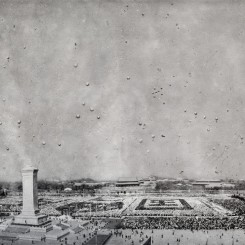Ground Control to Major Zhang
Confucius leaps up, smashes down, a sideshow scarecrow in a “Guantanamo-cage.” The monkeys go berserk, screaming, embracing, and fleeing the psychotic-robotic kabuki theater, actors and victims in it. (1) If it is about the environment, Confucianism and society, what the hell is this possessed, epileptic Confucius doing to the monkeys? And what is he doing to us?
***
Zhang Huan is patrician, aloof and mercurial, first distant, then charming, with a self-deprecating wryness. His eyes sparkle, or perhaps glint; his humor, sharp and dry. There is an air of a tiger aware of hunters. Part performance, one must play along without knowing the rules. Born in 1965 in Henan province, Zhang is younger, just, than all his equally famous contemporaries, who together have come to define contemporary art from China. (2)
He is still best known for his early actionist works of endurance, of masochism, self-abasement and abnegation, provocative certainly but also absurdist, the most famous being “12m2” (1994), in which he enclosed himself in a filthy, sweltering latrine, naked and covered with honey and fish oil, flies crawling over him. The photograph shows him, in profile, expressionless but somehow heroic, against the corruptions that besmirch him, metaphors for altogether filthier social and political corruption. But not passive: he leaves the shack and walks into the neighboring lake, fully immersing himself in its cleansing water.
It is a while though since Zhang Huan has used his body for his practice. In 2006, after eight years in New York, he returned to China, not to Beijing’s East Village where his artist career began but to Shanghai, where he established an art factory on the outskirts of the sprawling city, employing over 100 people. The huge enterprise seemed estranged from the asceticism of other performance artists, such as Marina Abramović, Tehching Hsieh and Vito Acconci (well, even Abramovíc’s “An Artist’s Life Manifesto” dinner-performance in 2011 at MoCA, Los Angeles was Satyriconesque).
Here Zhang developed a new practice with two related but distinct directions: wall-based works and sculptural/installation works. The wall-based works were either his now seemingly ubiquitous ash paintings or “Memory Doors,” tableaux expertly carved into weathered Chinese doors. The installation works have been fewer but no less prominent, usually involving towering theatrical scenes, and in one case a theatrical production of Handel’s opera “Semele” (2009). Often there are giants, a Madonna and Child made of cow hides, a pair of garish stainless steel pandas for Expo 2010 (just cynical or was his heart not in it?), Buddhas and Emperors composed of ash, Confucius sitting in his bath, even Zhang’s own avatar colossus — Zhang Huan’s world is crowded with slumping behemoths, sometimes literally as the ash forms disintegrate. How small we are compared to them, yet compared to us, how fragile too — daunting but enervated. (3) There have been lots of animals too — cows (or at least their hides), pigs, donkeys and monkeys — all relating somehow to Buddhism, the situation and role of the individual in the world.
__________________________
1. Exhibition, “Zhang Huan: Q Confucius,” at Rockbund Art Museum, Shanghai.
2. Ai Weiwei (b.1957), Cai Guo-Qiang (b.1957), Zhang Xiaogang (b.1958), Yue Minjun (b.1962) and Zeng Fanzhi (b.1964).
3. The complaint — it is too casual to be criticism — is that the ash technique has become a gimmick, a cash cow, for another of China’s artist giants, just another Deng Xiaoping capitalist. Certainly the works are popular. The extravagant effort required to make them, the precision of their manufacture, their cinematic scale and presence make them very attractive. Just flick through leading style or fashion magazines and sooner or later you will find one of Zhang’s ash paintings staring back at you. For example, “Bellevue von Manhattan” in Architectural Digest (Germany)[no. 134 (November 2012), p. 156] shows Diane von Fürstenberg at home in Manhatten, including Zhang Huan’s portrait of her, which dominates the sitting room. In the portrait Fürstenberg looks frightening, vampiric. Her frizzy hair forms a cave from which her head emerges medusa-like. She wears good luck charm earrings, not recherché but atavistic. Through slightly opened lips we glimpse even lower teeth. This work was originally part of the 2011 Diane Von Furstenberg exhibition “Journey of a Dress,” at the Pace gallery in Beijing’s 798 art zone, coinciding with fashion photographer Peter Lindbergh’s exhibition “The Unknown,” which opened during China Fashion Week at the Ullens Center for Contemporary Art. Enough said.
Compare also Zhang’s “Fresh Open Buddha Hand” 2007, made of copper, with Dahn Vo’s copper reconstruction of Eiffel’s Statue of Liberty, the individual parts of which have been distributed around the world.



